Melbourne Tram Museum
- Follow Melbourne Tram Museum on Twitter
- Follow Melbourne Tram Museum on Facebook
- Follow Melbourne Tram Museum on Instagram
- Follow Melbourne Tram Museum on Pinterest
- Follow Melbourne Tram Museum on Tumblr
- Subscribe to Melbourne Tram Museum's RSS feed
- Email Melbourne Tram Museum
The Northern Tramway Company
Whilst researching the early days of the Melbourne & Metropolitan Tramways Board my attention was drawn to the Northern Tramway Company, a horse drawn service running from the Melbourne Tramway and Omnibus Company (MTOC)’s Brunswick terminus at Moreland Road north along Sydney Road to Gaffney Street. It was the subject of a few paragraphs in Bob Prentice’s history of the Melbourne, Brunswick and Coburg Tramways Trust. Research on Trove soon suggested that this tramway was a product of the Land Boomers; almost all the promoters receive a mention in Cannon’s book on that fascinating period of Melbourne’s history.
Conception
The first mention of the Northern Tramway Company (NTC) is in March 1886 when ‘a number of gentlemen interested in land in the northern suburbs are prepared to form a company to be called the Northern Tramway Company’. This was in response to MTOC’s refusal to extend its cable line, then being constructed, beyond Moreland Road.
The NTC was formally proposed on 25 May 1886 at a public meeting in Coburg Shire hall. The interim committee was George Skinner, a Mr Brown, Thomas Fischer and W. Kelly as secretary. Their proposal to Coburg Shire Council on 8 June 1886 was for a horse tramway from Moreland Road along Sydney Road to O’Hea Street [1] opposite Pentridge Prison.
Another meeting, in June 1886, formed the company with a subscribed capital of £250,000 in £1 shares. The first issue of 50,000 shares were to be paid for at 1s on application, 1s on allotment with future calls of no more than 1s a month. They expected that 350 passengers a day at a 2d fare would pay expenses and if 500 were carried it would enable a dividend of 6%. Mr George Duncan, the Melbourne Tramway Trust’s engineer, advised that construction would cost around £10,000 and six cars would add another £2,500. The company was still not constituted by 22 June and from later events it appears that only 5000 of these shares were sold.
On 21 June 1886 Coburg Shire Council proposed delegating its tramway construction powers to ‘a company of gentlemen known as the Northern Tramway Company Limited’. On legal advice the proposed lease for 99 years was reduced to 30. The Governor-in-Council granted the Coburg Council authority to build the tramway in two sections: first Moreland Road to O’Hea Street and second from there to Gaffney Street. After much debate the Council delegated these powers to the NTC on 3 October 1887 which was confirmed on 25 October. The Company finally agreed to the terms of delegation in February 1888.
Meanwhile MTOC’s Brunswick cable line opened 1 October 1887.
Even though construction had not commenced the line appeared in land sales advertising, as in March 1888 for the Maybank Estate (Shaftesbury Street, Coburg), suggesting the planned four trams an hour would ‘be an important feature to the travelling public’.
A new prospectus was issued on 19 May 1888 offering 75,000 £1 shares to the public. The NTC’s directors now included an array of land-boomers:
- Frank Stuart, chairman [2], also a director of the Essendon Land and Tramway Co which paid £200,000 of shareholders funds to James Mirams of the Premier Building Association who in turn paid only 2d in the £1 in March 1890.
- James Munro, M.P., vice-chairman; became State Premier in 1890 and who had debts of £309,000 when bankrupted in February 1893 on which he paid zero. He absconded to London, self-appointed as Victoria’s Agent General.
- Thomas Fischer, bankrupted in November 1892.
- J. T. Vincent JP, accountant, bankrupted in 1893.
- P. Benson.
The issue’s brokers were Messrs Munro and Baillieu, better known as auctioneers and real estate agents, and described in The Land Boomers as ‘partners in audacity’. Donald Munro, son of James, went bankrupt in July 1892 and in his ‘secret composition’ agreed to pay 6d in the £1 on his £50,000 debt. W.L. Baillieu owed around £225,500 when bankrupted in June 1892 and his creditors also accepted 6d in the £1.
The bankers were the Commercial Bank of Australia Limited and The Federal Bank of Australia Limited. The latter, founded by James Munro in 1881, suspended payment and closed its doors in January 1893.
George Duncan, the Melbourne Tramway Trust’s engineer had been convinced to supervise construction and was said to have ‘expressed a most favourable opinion of the financial results of this undertaking’.
Of the 100,00 shares 5000 had been issued to the existing shareholders back in June 1886. Another 20,000 shares deemed paid up to 5s were also allotted to them from the new issue. They were also to benefit from £5,000 in cash ‘for a share in their goodwill in the undertaking of the company’. This was a classic land-boomer tactic quoting the company’s subscribed capital as one figure, taking a cash amount, and leaving the shareholders liable to calls. The 75,000 shares would raise £18,750 if paid to the expected 5s maximum leaving only £12,750 as cash for the NTC’s construction which was close to Duncan’s estimate earlier estimate. The completion date under the order was set as 17 January 1889.
In late May Munro and Baillieu reported that the second float had been successful and subscribed very many times over. By 29 June the shares were being quoted for sale on the market at only 4s each and fell to 3s by the end of July.
Construction and opening
Using shareholders’ funds to build a tramway was not a land-boomer’s highest priority. It was not until mid-September that tenders for construction, closing on 4 October, were called for the line and car house. Fifty ‘pick and shovel men’ were advertised for on 30 November. A tender issued for supplying horses for haulage closed on 10 January 1889. Tenders for erection of a stable for the NTC at Gaffney Street closed on 4 February 1889 at Munro and Baillieu’s office 7 Victoria Buildings, Swanston Street.
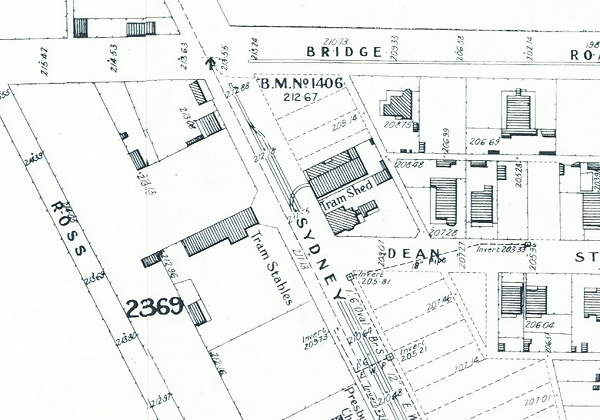
- Section of MMWB Map 110 showing location of stables and offices.
- Courtesy State Library Victoria.
A test trip was operated on Saturday 9 February 1889, and it was reported that cars were to run for traffic from 14 February. The service was running by 1 March with trips every 15 minutes from 7am until midnight.
A suggestion for duplicating the line was discussed at a general meeting on 20 May 1889. Frank Stuart chaired and remarked that the ‘shareholders had a first-class property which was improving every week’. He held 11,000 shares and had not sold one. A motion to confirm the company’s new regulations was moved by William John Malpas, a partner in the dubious Melbourne Joint Stock Bank which was wound up in October 1893 and its books destroyed.
A proposal to power the line electrically was made on 22 July 1889 by NTC’s secretary Salis Fischer and was supported by Coburg council. Salis, also manager of the Melbourne Trust Finance Company and associate of the notorious Theodore Fink, then aged 41, committed suicide in 1896 citing financial troubles.
In September 1889 William W. Macready (or McCredy), a dray driver delivering stone blocks, was convicted of obstructing the progress of a tramcar and assaulting NTC’s driver Burgess with a whip. He was fined 10s and 20s respectively.
In October 1889 the company met the council and stated that the horse tramway system had not worked well. Duplication and electrification were suggested. A new agreement allowing duplication was drafted.
Electrification was again discussed on 15 January 1890 at Coburg Council’s public works committee meeting. Addressed by Mr Booth (a well-known electrician from Booth, Ellison and Co) who outlined the overhead, storage and underground systems of current collection. He discounted the underground conduit system as being both expensive and difficult, and whilst the storage system was the safest and neatest, it was also the most expensive. The Julien battery car had been demonstrated in Melbourne in September 1888. He suggested 400v Direct current with 18 feet high centre poles. Booth was asked to prepare a report to Council which was delivered on 3 February. Nothing came of the proposal.
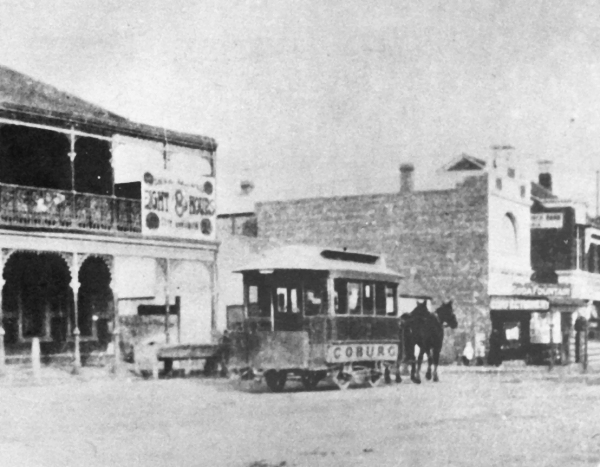
- NTC car on Sydney Road looking south at Warren’s corner.
- Photograph courtesy Coburg Historical Society.
At the half-yearly shareholders’ meeting Stuart reported a six-month loss of £46 7s 6d resulting from expenses of £194 10s 3d to repair the road from damages caused by brick and stone carters. The estimated cost of duplication was £10,000 which the Union Bank had promised to advance provided the NTC’s principal shareholders did not sell their shares for five years. An alternative was a call on shareholders for 2s 6d.
In October 1890 the Company objected to paying rates to Coburg Council on the tram line, on the grounds that it had no letting value, and that no rates are claimable under the original agreement. The following March the NTC appealed regarding the rates it was being charged for the tram track, stables and sheds. They were being valued at £250 but the appeal agreed that the tram tracks had no rateable value and the NTC’s rates were reduced from £16 to £6s 3d.
The contract for duplication was completed by Woolacott and Co in June 1891 at a cost of £20,000 and was opened on Monday 3 August 1891. It was formally celebrated on 13 August 1891 with a catered lunch at the tram-sheds attended by directors and councillors. The total costs were reported as £35,000 and running costs £2000 a year. Two additional second-hand MTOC five window cars were purchased for the duplication.
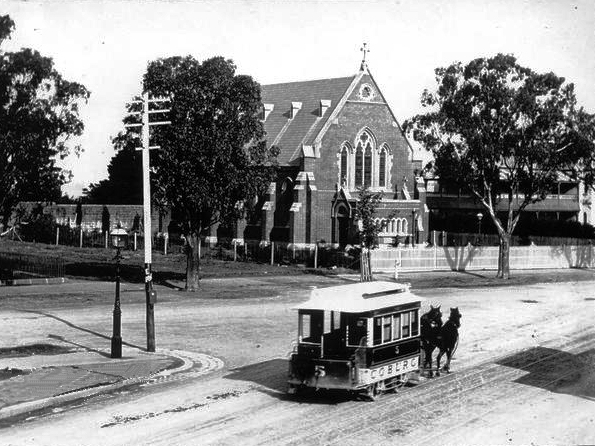
- NTC car outside St Paul’s Church at O’Hea Street.
- Photograph courtesy Coburg Historical Society.
Insolvency
Despite the bonhomie of the duplication celebration the employees were not happy. In September 1891 they drew up a petition asking for daily hours to be reduced from 12½ to 9. Two men were dismissed, one being Mr S. O’Keefe, recently employed as a driver and road blocker – also secretary of the Progressive Political League and trying to form its Coburg branch. Another employee, Mr Dunstone, after signing was asked to accept a wage reduction from £2 5s to £2, and on refusing was also dismissed. A strike was threatened.
The NTC’s perspective, in a letter from William Ewins, was that passenger levels were falling and revenue reducing. Dunstone had his pay raised to £2 5s only a few weeks earlier and this was a request unrelated to the petition. Dunstone, a night groom (who had only recently joined the NTC from the Clifton Hill – Northcote line) was offered a few days’ grace but decided to leave anyway. O’Keeffe, who was accused of authoring the petition, is alleged to have asked another employee, R. Burgess, to claim authorship.
When NTC director Thomas Fischer filed for insolvency in November 1892, owing a staggering £185,218 18s 11d, his largest unsecured creditor was the Northern Tramway Company at £8,272 12s 4d; he held 10,785 shares in the NTC.
The following month the NTC proposed that Coburg Shire Council purchase it. The estimated construction and equipment cost was £27,000. The company had not been in ‘a very flourishing condition’ and unless some action was taken the cars would cease running. The council would have had to raise a loan to undertake the purchase and with diverse opinions on the matter it was deferred.
The tramway struggled on through 1892 and 1893 with Council unable to decide until May 1894 when it was decided to acquire the NTC for £12,500. Even this was objected to by many of the residents and a petition was sent to the Minister of Public Works asking him not to sanction the transfer.
The NTC deemed the situation too difficult and went into liquidation. On 26 May their liquidator, Salis Fischer, offered the NTC’s manager, William Ewins (already aged 69), the use of the company’s plant. The liquidator took responsibility for all debts to date whilst Ewins was to cover expenses from revenue. After consulting with the employees, a co-operative arrangement was agreed to, two drivers made redundant, and fares reduced from 3d to 2d, or packs of four for 6d. The new arrangement started on 4 June.
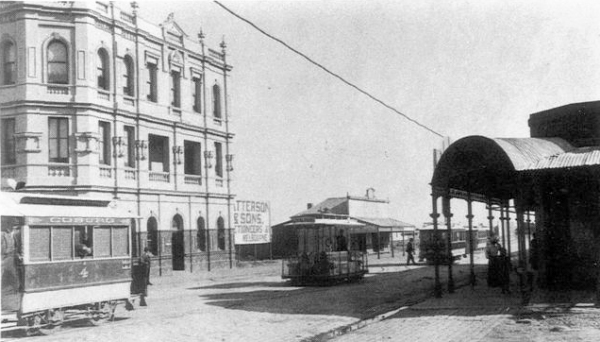
- Horse car and shunting cable cars at Moreland Road.
- Photograph courtesy Coburg Historical Society.
Struggling on
By February 1897 the tramway was in trouble again. The liquidator, now Mr J. Butler, suggested that if the Council did not want to take over the asset, the company would remove the rails. Council did nothing until May when the liquidator set 24 May as a deadline when the trams would stop. Council’s feeling was that the NTC could not lift the rails and applied to have the NTC’s delegated rights forfeited.
In September Ewins wrote to Coburg Council that a meeting of property owners and influential ratepayers had met and suggested that a new company could be formed to take over the NTC. Council appeared favourable. On 13 September another letter was received from J. Drysdale, John Caton and Alfred Buck also wrote suggesting a company to maintain the service. Council was to maintain the roads.
Ewins proposed to electrify the line in October 1901 with overhead using either centre poles, as in Sydney, or side poles, poles to be 20 feet high, and powered by an 80hp to 100hp steam plant located mid-way along the line. Speed was to be 15mph with a possible maximum of 25mph. To enable electrification Council would to appeal to the Governor-in-Council for an order under the Tramways Act 1890, and then delegate the authority to Mr Ewins. Council’s engineer supported central posts but they would need to be lit all night which would enable their 24 gas lamps to be replaced; this would increase land values. Council agreed to share costs with Ewins. Nothing became of the proposal.
Ewins is reported in April 1904 as offering the NTC to A.C. Morgans of Perth. At the time Morgans was promoting electric tramways in Essendon after being unsuccessful in a similar scheme in Perth.
The Coburg Council was often dissatisfied with the condition of Sydney Road, in April 1904 suggesting top-sheeting with tar was preferred to the present system of relaying small numbers of the blocks in sand. It instructed its solicitor to enforce the NTC’s contact. Ewin’s response highlighted the ongoing issue with tramway acts which forced the operator to maintain 18 inches on either side of the track which was then used by the horse-hauled traffic. Many operators saw this as a way to reduce the council’s costs at the operator’s expense, the edges of the road needing less maintenance. Ewins wrote ‘All the clay used in the potteries in Brunswick passes over the road daily in strings of twenty carts each carrying two tons or more. Also. there is the heavy spawl and pitcher [3] carting from the Newland quarries and the general traffic, heavy and light.’ Operators argued that they paid council rates as well as paying for maintenance for space that they did not have exclusive use of. Council was to periodically complain about Sydney Road’s surface for the rest of the tramway’s life.
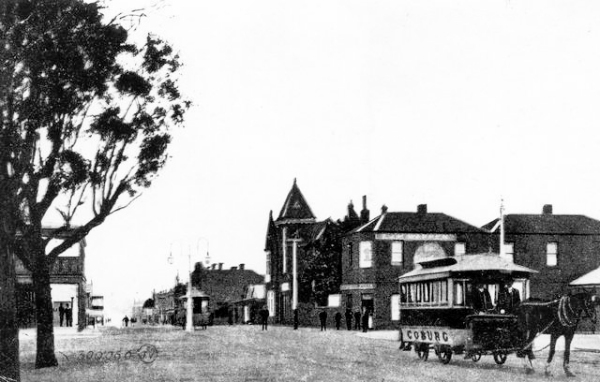
- NTC car at the corner of Sydney Road and Bell Street.
- Photograph courtesy Coburg Historical Society.
Coburg’s President, Arthur Voice, replied arguing that Ewins had done little maintenance and that in some places the rails were two inches above the road preventing traffic from using the tramway. A few weeks later some ratepayers petitioned defending Ewins ‘as during the 15 years of his management he had done the best that circumstances permitted’.
Ewins suffered a heavy loss in April 1904, when one of his horses, valued at £20, died. His tram driver, Michael Roberts, had just reached Moreland Grove at 10.30pm when the horse dropped dead.
The only recorded fatality on the line occurred on 18 December 1904 when ten-year old Albert Pearce jumped off a moving tram and fell under the wheels. The Coroner observed that school boys frequently jumped on at the front whilst the driver was collecting fares at the back. The inquest returned a finding of accidental death.
In June 1907 Ewins went before the Coburg court to reclaim £1 12s from a patron for use of eight months of tickets. The defendant did not appear and Ewins was awarded the amount plus 18s costs.
The Coburg Leader lauded the introduction in August 1907 of a Sunday service using a ‘handsome drag’ from Bell Street to the Coburg Cemetery half-hourly between 2pm and 5pm. A daily ‘commodious waggonette’ provided a service from the terminus to the New General Cemetery and Campbellfield at 9am, 2pm and 6:15pm, with return departures 45minutes later. The tram service operated every ten minutes using five twenty-two seat cars. Twenty-four horses worked three to four hour shifts with ten drivers. Fares were 1d per section, Bell Street being the section point, but 1½d two section tickets were available from drivers in packs of four for 6d. A monthly ticket was available for 4s, and 2s6d for children and apprentices. The monthly oat bill was around £20 and all shoeing and blacksmithing took place in Coburg.
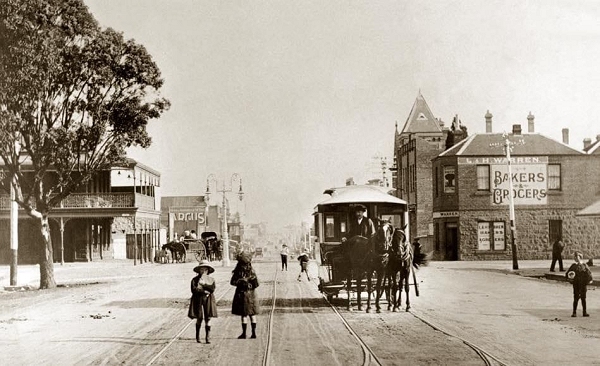
- NTC car at the corner of Sydney Road and Bell Street looking south, c1905, Kingdon’s hotel on left.
- Photograph courtesy Coburg Historical Society.
Electrification again
The NTC again proposed electrification to Council in July 1907 and it was accepted subject to a £250 deposit and an agreement on terms within three months. A member of the Coburg Progress Association (CPA), Mr Shaw, said an American journal noted that the tram service was ‘the slowest means of locomotion on the face of the earth’.
A few days later the CPA had received a proposal from a ‘motor car operator’ offering a five-minute bus service from O’Hea Street to Moreland Road using three or four 15-seat buses. The CPA would pay licence fees which would be refunded if the service was successful.
In September 1907 the CPA suggested the Coburg Council should hold a public meeting to discuss acquiring and electrifying the tramway. Ewins wrote to council in October ‘desirious of improving and extending the tramway system, and if possible of providing for its electrification’. The debate on electrification and road maintenance was to continue through 1908.
The CPA’s plans developed, by January 1908, into a proposed company to provide power to Coburg, part of Brunswick and the tramway. The cost was estimated at £25,000 and revenue around £6000 a year. Coburg Council was unable to assist with funds, but if work was completed within three years it would then grant a 25-year lease.
Who’s lease?
In November 1908 William Ewins’ son, Harold, acting for his ageing father, invited the Coburg Council to purchase the tramway at valuation. He was invited to attend the Finance Committee’s next meeting. Nothing came of this offer and it was offered for sale again in June 1909 when William Ewins admitted he was unable to keep the track in repair.
Harold informed Council that he had sold NTC to Mr Hubert Junker on 16 July 1909, however the transfer of the lease was delayed by Council. Junker, whilst contemplating electrification, objected to Clause 1 of the NTC’s agreement which required the lessee to maintain the track and imposed a £5 daily penalty for neglect. On 1 September Junker was given 21 days to make up his mind or else council would refuse the transfer and proceed against Mr Ewins.
Council engaged King’s Counsel Mr Mitchell for an opinion on who should be pursued for road works. In his opinion, given in March 1910, it was William Ewins and Herbert Junker. He also suggested that it would be relatively easy for Council to obtain an Act to enable it to acquire the tramway.
The issue of fair wages for NTC employees was raised in October 1909 when one of the employees claimed he worked from 4:30am until 6:30pm with two hours for meals, seven days a week for 25s. Council agreed to add a fair wages clause to the lease.
In March 1910 Junker transferred ownership of the NTC to his son-in-law, Archibald Peers. Peers also refused to accept Clause 1 but proposed to pay council £175 and then £75 a year towards Council keeping the track and road in order. Council agreed to this but still declined to transfer the lease to him.
Hubert Junker committed suicide by taking strychnine on 22 June 1910. He had also been licensee of Fairfield’s Grand View Hotel and had previously threatened to take his own life.
To further complicate matters, William Ewins died on 14 August 1910 at the age of 85. This meant that, as incumbent operator but without a signed lease, Peers was the only person Council could deal with.
Complaints about the tram service continued regarding infrequent and slow service; it was said to be quicker to walk. In January 1911 Council served a writ on Peers to prevent him using the tramway as a trespasser without a lease.
Council operation
Council finally resolved the impasse by purchasing the NTC from Peers in August 1911 for £2,100. At the same time, they agreed to cease the expensive litigation against him and Ewins’ estate. Purchase was funded by a loan from the AMP Society at 4.5% interest. Council also agreed to pay the employees decent wages.
W.F. Skinner was appointed tramway manager and by February 1912 the service had improved considerably with returns increasing. Tickets were introduced in May 1912 despite a lack of enthusiasm by local businesses to advertise on them.
During 1912 Brunswick and Coburg councils started discussions which led to the formation of the Melbourne, Brunswick and Coburg Tramway Trust. The Trust’s first meeting was on 28 February 1914 and on 22 March the Coburg horse tramway was transferred to the Trust’s control. A year later the Trust paid the Council £2646 for the system including buildings and rolling stock. The Trust finally rectified the road surface problem by laying asphalt on the tramway.
Unwept
The trams ceased running beyond Bell Street on 2 December as track removal began. The last tram left Moreland Road at 11:05pm on Sunday 5 December 1915. This enabled the Melbourne, Brunswick and Coburg Tramways Trust to complete the removal of the old track in preparation for laying the new electric tramway. The Trust’s chairman, Mr T.O’L. Reynolds, the Mayor of Coburg. Cr A.T. Hackett JP, and Cr A.G. Campbell boarded the tram and a small crowd gathered to witness its departure. Driver Frank Keane was in charge and later on, Mr Harry Bates, who drove the first NTC horse trams, took the reins and drove in the last time. The track was roped off and the former passengers of what was variously described as the ‘penny struggle’ and hearse tram were catered for by ‘drags’ (a type of horse-drawn open vehicle).
A poem read:
It is hard to recall old Noah of old,
With his ponderous, cumbersome Ark,
But really, I think, if the truth must be told,
To the Coburg horse tram, it’s a lark.
I’ve heard of camels and even of mules,
As transport, sometimes e’en worse;
But the lot of them certainly rank as mere fools
To the tramways known as ‘the hearse’.
On Thursday 11 May 1916 the horses and property were auctioned. The harnesses brought a ‘fair price’. Mr Dwerryhouse, of Fawkner, purchased three of the cars at £6, £5/10/- and £4/10/-. Mr Reg Crosbie Bentwick purchased one at £7/10/-. The four roomed caretaker’s cottage with car shed and offices, standing on 50 feet of land, only realised £400, while the 20ft × 130ft galvanised iron and wooden stables went for £75.

- Coburg horse tram rails being removed south of Bell Street in late 1915.
- Photograph courtesy Coburg Historical Society.
Footnotes
[1] In contemporary reports, O’Hea Street is called a range of different names, including O’Heas’s Road, O’Hea’s Road and O’Hea Street.
[2] Cannon, Michael. (1972), The Land Boomers, page 150.
[3] Spawl – fragments of stone with one thin edge. Pitcher – granite setts for paving.
Bibliography
Books
Cannon, Michael. (1972), The Land Boomers: The Complete Illustrated
History, Lloyd O'Neil, Melbourne
Prentice, Bob and Filigate, Dean (Ed); A Brief History of the Melbourne
Brunswick and Coburg Tramways Trust; Tramway Publications Inc, Melbourne,
1999
Richardson, J, The Essendon Tramways, Traction Publications, Canberra,
1963, page 7
Newspapers
The Age (Melbourne, Victoria) : 1854 – 1954
The Herald (Melbourne, Victoria) : 1861 – 1954
The Argus (Melbourne, Victoria) : 1848 – 1957
The Coburg Leader (Victoria) : 1890 – 1913
Western Mail (Perth, Western Australia) : 1885 – 1954
Brunswick and Coburg Leader (Victoria) : 1914 – 1918
Labor Call (Melbourne, Victoria) : 1906 – 1953